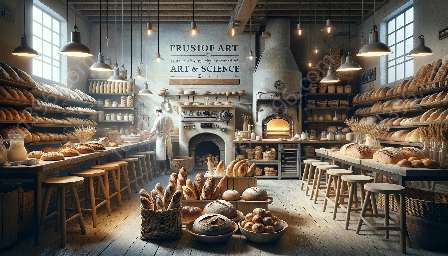In the art of baking, fermentation and dough development play crucial roles in creating the perfect loaf of bread or batch of pastries. These processes are essential for achieving the desired texture, flavor, and structure in baked goods. This topic cluster explores the intricate mechanisms of fermentation and dough development, with a focus on how traditional artisan techniques intersect with modern baking science and technology.
The Role of Fermentation in Baking
Fermentation is a natural process that involves the breakdown of complex substances into simpler compounds by the action of microorganisms, such as yeast and bacteria. In baking, fermentation is primarily associated with the leavening of bread and the development of flavors.
During fermentation, yeast consumes sugars and produces carbon dioxide gas and alcohol. The carbon dioxide gas forms bubbles in the dough, causing it to rise and create a light, airy structure in the final baked product. Additionally, the byproducts of fermentation contribute to the nuanced flavors and aromas in bread, giving each loaf its unique character.
Artisan Approach to Fermentation
Artisan bakers often employ traditional fermentation techniques, such as sourdough starter, to cultivate natural yeast and bacteria for leavening. A sourdough starter is a mixture of flour and water that captures wild yeast and bacteria from the surrounding environment. This method reflects the artisanal commitment to harnessing the natural processes of fermentation to create distinct and flavorful bread.
Baking Science and Fermentation
From a scientific perspective, the understanding of fermentation in baking has expanded with technological advancements. Modern bakers can control fermentation parameters, such as temperature and hydration, to optimize the activity of yeast and bacteria. Additionally, research in microbiology and biochemistry has shed light on the complex interactions that occur during fermentation, leading to improved methods for achieving consistent and high-quality results.
Dough Development and Gluten Formation
When flour is mixed with water, a series of transformations occur that are essential for dough development. One of the key processes is gluten formation, which gives the dough its elasticity and strength. Gluten is a network of proteins, primarily glutenin and gliadin, that form when flour is hydrated and kneaded.
Artisan techniques often emphasize the importance of gentle handling and prolonged fermentation to allow for gradual gluten development. This approach results in a well-structured dough that is capable of retaining gases produced during fermentation, leading to an open crumb and a light texture in the finished baked goods.
Integrating Traditional and Modern Techniques
Artisan and traditional baking techniques have evolved alongside advancements in baking science and technology. While some bakers continue to adhere to time-honored methods of hand mixing and long fermentation, others have embraced modern equipment and processes to streamline production without compromising the integrity of their baked goods.
Baking science and technology have provided tools such as dough hydrators, advanced ovens, and precise temperature controls, allowing bakers to achieve consistent results while preserving the essence of artisan craftsmanship. These innovations complement traditional practices, enabling bakers to adapt to changing consumer demands and market dynamics without forsaking the heritage of their craft.
Conclusion
Fermentation and dough development are integral aspects of baking that bridge the realms of tradition and innovation. By understanding the dynamics of fermentation, the nuances of dough development, and the interplay between artisan techniques and modern science, bakers can master the art of creating exceptional baked goods that captivate the senses and honor the heritage of their craft.



